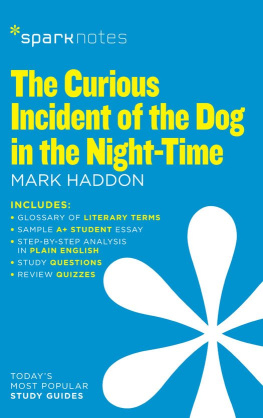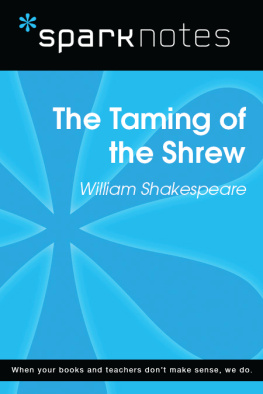All rights reserved. No part of this publication may be reproduced, stored in a retrieval system, or transmitted in any form or by any means (including electronic, mechanical, photocopying, recording, or otherwise) without prior written permission from the publisher.
Please submit changes or report errors to www.sparknotes.com/errors.
CONTEXT
Mark Haddon was born in Northampton, England, in 1962. He graduated from Merton College, Oxford, in 1981, and later returned to his studies at Edinburgh University, where he received a masters degree in English literature. After college, Haddon took a number of odd jobs, including one working with children who had physical and mental disabilities, including autism. He also worked as an illustrator and cartoonist, contributing to a number of prominent British publications. In 1987, Haddon published his first book, Gilberts Gobstopper, about a piece of candy that, over the course of fifty years, gets bounced around the world until it returns to Gilbert, the boy that dropped it (he is an old man by the time it returns). Haddon followed with more than a dozen works for children over the years, many of which he also illustrated, and became involved in writing for childrens television. For the British childrens show, Microsoap, in particular, Haddon won multiple awards, including the Royal Television Societys honor for Best Childrens Drama.
In 2003, Haddon published The Curious Incident of the Dog in the Night-Time, his first foray into adult fiction. The book follows Christopher John Francis Boone, a young boy whose symptoms and behavior suggest he has a mild form of autism, perhaps Aspergers Syndrome. The book came out in England in two imprints, one aimed at young adults and one at adults, though no differences separated the two editions other than a slight change in the cover artwork. Haddons novel immediately won fans in each group, quickly selling more than a million copies in both markets, in no small part because of the unique voice of its narrator. The book earned critical acclaim as well, receiving praise from outlets like the The New York Times and from noted authors including Ian McEwan. To date, The Curious Incident of the Dog in the Night-Time has been published in more than thirty-five countries and has become an international bestseller. In the United Kingdom, Haddons book has sold more than 2.6 million copies, making it the third best-selling book of the decade.
Had The Curious Incident of the Dog in the Night-Time come out ten years earlier, it might have had a difficult time finding grown-up readers. In the early 1990s, few novels about young protagonists found success with adults. But the immense popularity of J.K. Rowlings Harry Potter books, and to a lesser degree Phillip Pullmans His Dark Materials series, both of which featured young protagonists coming of age against the backdrop of a dramatic storyline, helped change the way audiences received stories about young adults. Both series achieved popular as well as critical success, with Rowlings books in particular among the biggest sellers of all time. Even though Rowling and Pullman wrote their books for younger audiences, while Haddon wrote his for adults, Haddons novel found the same kind of crossover appeal. Reflecting this success across age groups are the numerous awards the book has won, which include the Whitbread Book of the Year Award, the Guardian Childrens Fiction Prize, and the Booktrust Teenage Prize.
Despite his work with autistic children, Haddon staunchly asserts that he is not an authority on autism and claims to have done very little research on the subject before writing the novel. In an interview with Powells Books, Haddon said that when he worked with autistic children, autism wasnt a term that was even used much at the time, and only in retrospect do I realize that some of the people I worked with had autism, although they had it much more seriously than Christopher does. Although the novel never mentions autism, Christopher, the novels protagonist, displays several of the symptoms that characterize the disorder, such as difficulty reading facial expressions, preoccupation with certain topics, and behaviors like rocking back and forth. Additionally, many of the press releases put out by the publisher, as well as the packaging of certain editions of the book, describe Christopher as autistic. The autistic community has criticized the book for offering an inaccurate depiction of the condition. Haddon, however, says he intended his book only as a work of fiction and not a medical treatise on living with autism.
PLOT OVERVIEW
The Curious Incident of the Dog in the Night-Time takes place in the year 1998 in and around the town of Swindon, England. The fifteen-year-old narrator of the story, Christopher John Francis Boone, discovers the slain body of his neighbors poodle, Wellington, on the neighbors front lawn one evening and sets out to uncover the murderer. His investigation is at times aided, and at other times hampered, by the mild form of autism he lives with. After Christopher hits a policeman in a misunderstanding at the scene of the crime, the police take Christopher into custody. They release him with only a stern warning, on the condition that he promises them and his father not to look into the murder any further.
Christopher chronicles his investigation in a bookthe book we are readingas part of a school assignment. Ignoring repeated warnings from his father, Christopher investigates the crime scene and conducts interviews with the residents of his block. He uncovers a more tangled plot than was first apparent when he discovers that his father and the owner of the slain dog, Mrs. Shears, had a romantic affair. He subsequently learns that their affair began in reaction to another relationship, one carried on between Mr. Shears and Christophers mother, before she disappeared from Christophers life.
At school, Christopher prepares for an A-level math exam that will enable him to attend college, a feat no other student at his school has managed. He also continues to work on his book. Upon returning home one afternoon, Christopher accidentally leaves his book in plain view on the kitchen table. His father reads it, becomes angry, and confiscates it. Later, Christopher searches for the book and uncovers a series of letters, hidden in a shirt box in his fathers closet, addressed to him from his supposedly dead mother. The letters chronicle the life that his mother has continued to lead with Mr. Shears in London and contain repeated requests for Christopher to respond. In shock, Christopher passes out in his bedroom surrounded by the evidence of his fathers deception. When Christophers father comes home and realizes what has happened, he breaks down in tears. He apologizes for his lies, explaining that he acted out of a desire to protect Christopher from the knowledge of his mothers abandonment of the family. Christophers father also admits to killing Wellington after an argument with Mrs. Shears, his lover.
Christopher, now terrified of his father and feeling he can no longer trust him, sneaks out of the house and travels to London to live with his mother. During a harrowing journey, he copes with and overcomes the social fears and limitations of his condition, dodges police, and almost gets hit by a train. His arrival at his mothers flat comes as a total surprise to her, as she had no idea that Christophers father had been withholding her letters. Christopher settles in for a time at his mother and Mr. Shearss flat, but friction caused by his presence shortly results in his mothers decision to leave Mr. Shears to return to Swindon. Christopher moves into a new apartment with his mother and begins to receive regular visits from his father. When Christophers pet rat, Toby, dies, Christophers father gives Christopher a puppy. At school, Christopher sits for his A-level math exam and receives an A grade, the best possible score. The novel ends with Christopher planning to take more A-level exams in physics and advanced math and then attend college in another town. He knows that he can do all of this because he solved the mystery of Wellingtons murder, was brave enough to find his mother, and wrote the book that we have read.


















